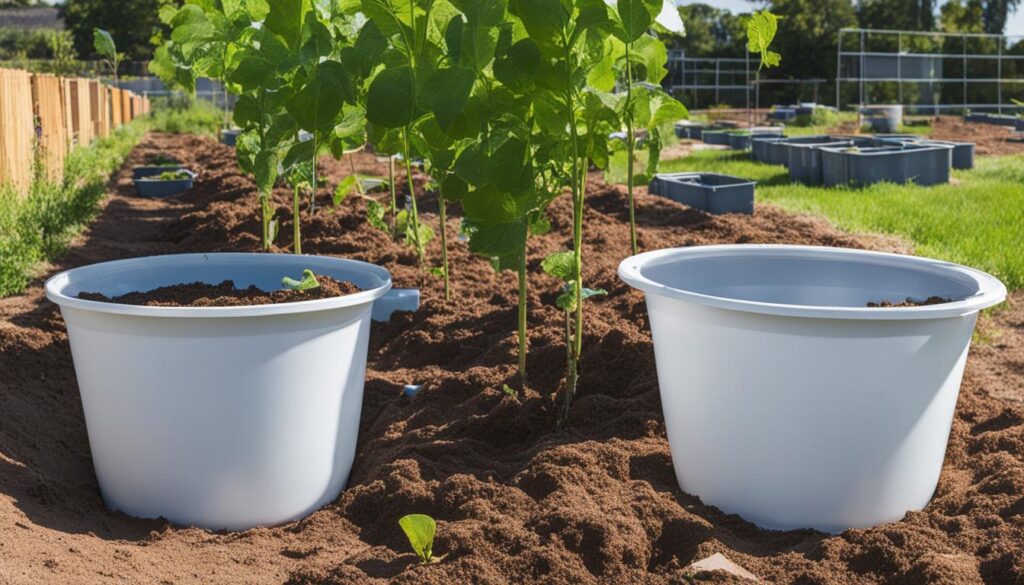A xeriscape plan for schools is an eco-friendly landscaping approach that focuses on water conservation. By implementing this sustainable plan, schools can not only create an attractive landscape but also promote environmental responsibility and inspire students to learn about water conservation.
In a xeriscape plan, careful planning and proper plant selection are key. By choosing plants that are suited to the local climate and require minimal water, schools can significantly reduce water consumption. Efficient irrigation systems and the use of mulch further help conserve water and create a sustainable landscape.
Key Takeaways:
- Xeriscape plans for schools focus on eco-friendly landscaping and water conservation.
- The plan involves careful planning, proper plant selection, efficient irrigation, and the use of mulch.
- Xeriscape can reduce water consumption by up to 50% compared to traditional landscapes.
- Implementing a xeriscape plan in schools promotes environmental responsibility and inspires students to learn about water conservation.
- By following the seven steps of xeriscape and incorporating water-saving techniques, schools can conserve water resources and create a sustainable landscape.
The Seven Steps of Xeriscape
The seven steps of xeriscape provide a systematic approach to creating a water-wise landscape for schools. By following these steps, you can design and implement a xeriscape plan that conserves water, minimizes maintenance, and creates an aesthetically pleasing environment for students and staff.
1. Proper Planning and Design
Start by carefully planning and designing your xeriscape plan. Assess your school’s existing landscape, taking into account factors such as site exposure, slope, and existing structures. Create a base plan that highlights these elements and consider grouping plants with similar water and light requirements into appropriate plant zones. By considering factors like sun exposure, wind conditions, and drainage patterns, you can select the right plants for each area and minimize water waste.
2. Soil Analysis and Improvements
Next, analyze your soil to understand its composition and moisture-holding capacity. Improve the soil by adding organic matter such as compost or well-rotted manure to enhance its structure and water retention. This will ensure that your plants have optimal growing conditions and can efficiently utilize water resources.
3. Appropriate Plant Selection
Choose water-efficient plants that are well-suited to your region’s climate and soil conditions. Native and drought-tolerant plants are excellent choices for xeriscapes, as they require less water and are better adapted to local environmental conditions. Consider incorporating a variety of plant types, including grasses, shrubs, and flowering perennials, to create a diverse and visually appealing landscape.
4. Practical Turf Areas
While turfgrass provides a lush, green look, it can be a water-intensive option. To reduce water consumption, consider minimizing the amount of turfgrass in your xeriscape plan. Identify areas where turf is necessary, such as play areas or sports fields, and choose drought-tolerant grass varieties that require less water. Incorporating alternative turf options like buffalo grass or fine fescues can also help conserve water while maintaining an attractive landscape.
5. Efficient Irrigation
Adopt efficient irrigation practices to ensure that water is used wisely in your xeriscape. Consider using low-pressure sprinklers for turf areas and drip emitters for trees, shrubs, and flowers. These systems deliver water directly to the plants’ root zones, minimizing evaporation and runoff. Install rain sensors and timers to automate irrigation schedules and prevent overwatering.
6. Use of Mulch
Apply a layer of organic mulch, such as wood chips or bark, around plants and in bare soil areas to help retain moisture and suppress weed growth. Mulch acts as a natural insulator, reducing soil evaporation and maintaining consistent soil temperature. It also adds a decorative element to your landscape, enhancing its visual appeal.
7. Appropriate Maintenance
Maintain your xeriscape plan by practicing appropriate maintenance techniques. This includes regular pruning, weeding, and monitoring for pests or diseases. Adjust your irrigation schedule seasonally to account for changing weather conditions. By properly caring for your xeriscape, you can ensure its longevity and continued water conservation benefits.
Incorporating these seven steps into your xeriscape plan will help you create a beautiful, water-efficient landscape for your school. It will not only conserve water but also provide an opportunity to educate students about the importance of water conservation and sustainable practices. By implementing xeriscape principles, schools can contribute to a greener and more eco-friendly future.
Planning and Designing the Xeriscape Plan
When creating a xeriscape plan for your school, the first step is to carefully plan and design the layout of your landscape. This involves conducting a site analysis to understand factors such as sun exposure, wind conditions, and drainage patterns. By considering these factors, you can determine the most suitable areas for different types of plants and minimize water waste.
Once you have completed the site analysis, it’s important to create a base plan that highlights existing structures and vegetation. This will serve as a guide for the implementation of your xeriscape plan. Additionally, grouping plants with similar water and light requirements into specific plant zones will help ensure their optimal growth and minimize water usage. This zoning technique allows you to efficiently irrigate different areas based on their specific needs.
When selecting plants for your xeriscape plan, opt for water-efficient varieties that can thrive in your local climate and soil conditions. Native plants are often a great choice as they have adapted to the local environment and require minimal water once established. Incorporating a variety of plants with different heights, colors, and textures will add visual interest to your landscape while still maintaining water efficiency.
By carefully planning and designing your xeriscape plan, you can create a visually appealing and eco-friendly landscape for your school. Not only will this help conserve water resources, but it will also provide an educational opportunity for students to learn about the importance of water conservation and sustainable practices.
Selecting Water-Efficient Plants
One crucial aspect of planning your xeriscape plan is selecting water-efficient plants that can thrive with minimal irrigation. Native plants are a great choice as they are naturally adapted to the local climate, soil, and water conditions. They require less water once established and are generally more resistant to pests and diseases.
- Research plants native to your region that have low water requirements.
- Consider the plant’s growth habits, such as its size and spread, to ensure it fits within your designated plant zones.
- Choose plants with attractive foliage and flowers to enhance the visual appeal of your landscape.
- Group plants with similar water needs together to optimize irrigation efficiency.
By selecting water-efficient plants, you can create a beautiful landscape while conserving water resources.
Maintaining Plant Zones
Once you have established plant zones in your xeriscape plan, it’s important to maintain them properly to ensure the long-term success of your landscape.
- Regularly monitor soil moisture levels and only water when necessary to avoid overwatering.
- Implement a proper irrigation schedule based on the water needs of the specific plant zones.
- Regularly inspect plants for pests and diseases and take appropriate measures to prevent or control infestations.
- Prune plants as needed to maintain their shape and size, promoting healthy growth.
- Remove any weeds that may compete with your water-efficient plants for valuable resources.
By following these maintenance practices, you can ensure the longevity and beauty of your xeriscape plant zones.
Implementing Water Conservation Techniques
Implementing water conservation techniques is a crucial aspect of successfully creating a xeriscape plan for schools. By adopting these techniques, schools can not only save water but also create a sustainable and environmentally friendly landscape. Here are some key techniques to consider:
- Soil improvements: Enhancing the soil’s structure and moisture-holding capacity is essential for water conservation. Adding organic matter can improve soil quality and help retain moisture, reducing the need for frequent watering.
- Efficient irrigation: Implementing efficient irrigation practices is vital to minimize water wastage. Consider using low-pressure sprinklers for turf areas and drip emitters for trees, shrubs, and flowers. This allows for precise watering while reducing runoff and evaporation.
- Mulching: The use of mulch is an effective way to conserve soil moisture and suppress weed growth. Applying a layer of organic mulch around plants helps retain water, minimize evaporation, and reduce the need for frequent watering.
- Turf alternatives: Reducing the amount of turfgrass can significantly contribute to water conservation. Consider incorporating low-water-use plants that require less irrigation or explore alternative turf options like buffalo grass or fine fescues that are more drought-tolerant.
By implementing these water conservation techniques, schools can create a sustainable landscape that not only saves water but also reduces maintenance efforts. These techniques are vital components of a xeriscape plan and contribute to the overall success of creating an eco-friendly and water-wise environment for students and staff.
Conclusion
Creating a xeriscape plan for schools offers numerous benefits for your institution and the environment. By implementing the seven steps of xeriscape, you can create a water-wise landscape that promotes conservation, reduces maintenance, and enhances the aesthetic appeal of your school grounds.
Implementing water-saving techniques like efficient irrigation and mulching not only helps conserve our precious water resources but also reduces water bills. With careful planning and proper plant selection, you can create a sustainable landscape that thrives with minimal water consumption.
A xeriscape plan also provides an excellent opportunity for environmental education. By showcasing the importance of water conservation and sustainable practices, you can educate your students about their role in creating a greener and more eco-friendly future. Your xeriscape plan will serve as a living example of water-wise landscaping, inspiring students to become environmental stewards.
By embracing xeriscape principles, your school can contribute to a more sustainable future while enjoying the benefits of a beautiful and environmentally-friendly landscape. Start planning your xeriscape plan today and create a lasting impact on your school community and the planet.












